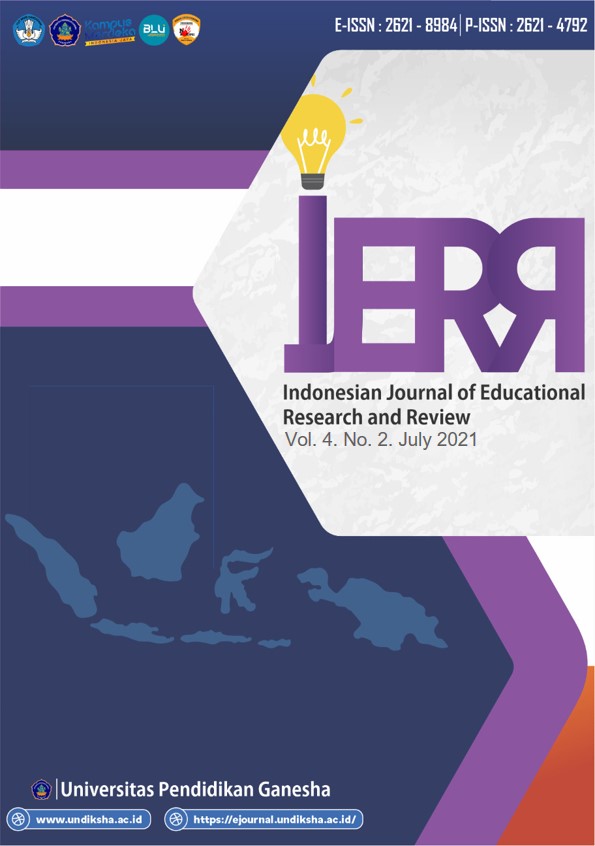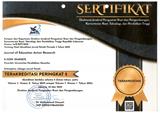Students' Learning Difficulties Review from Mathematics Problem-Solving Ability in Third-Grade Elementary School
DOI:
https://doi.org/10.23887/ijerr.v4i2.30310Kata Kunci:
Learning Difficulties, Problem Solving, FractionsAbstrak
Difficulty in the calculation process. It has an impact on low mathematics learning outcomes for students. This study aims to analyze students' learning difficulties in terms of mathematical problem-solving abilities in grade III elementary school fractions. This type of research is descriptive qualitative research. The subjects taken were six students—data obtained through interviews, tests, and documentation. The instrument used to analyze the data is a questionnaire. The technique used to analyze the data is descriptive qualitative and quantitative analysis. The study results are that students have a score on the aspect of understanding the problem of 50 (33.3%) in the medium difficulty category. The planning aspect has a score of 34 (22.60%) (great difficulty). Implementing the plan has a score of 95 (63.30%) (low difficulty). The re-checking aspect has a score of 98 (65.30%), which is in the low difficulty category. The difficulty is due to the lack of understanding of the questions, errors in determining the correct strategy to solve the problems and difficulties in the calculation process, and the child's low grasping power.
Referensi
Abrami, P. C., Bernard, R. M., Borokhovski, E., Wade, A., Surkes, M. A., Tamim, R., & Zhang, D. (2008). Instructional interventions affecting critical thinking skills and dispositions: A stage 1 Meta-Analysis. Review of Educational Research, 78(4), 1102–1134. https://doi.org/10.3102/0034654308326084
Ambussaidi, I., & Yang, Y.-F. (2019). The Impact of Mathematics Teacher Quality on Student Achievement in Oman and Taiwan. International Journal of Education and Learning, 1(2), 50–62. https://doi.org/10.31763/ijele.v1i2.39
Cheung, S. K., & Yin, J. L. (2021). Parents’ Perceived Goals for Early Mathematics Learning and Their Relations With Children’s Motivation to Learn Mathematics. Early Childhood Research Quarterly, 56(3), 90–102. https://doi.org/10.1016/j.ecresq.2021.03.003
Chityadewi, K. (2019). Meningkatkan Hasil Belajar Matematika pada Materi Operasi Hitung Penjumlahan Pecahan dengan Pendekatan CTL (Contextual Teaching and Learning). Journal of Education Technology, 3(3), 196–202. https://doi.org/10.23887/jet.v3i3.21746
Dinayusadewi, N. P., Ngurah, G., & Agustika, S. (2020). Development Of Augmented Reality Application As A Mathematics Learning Media In Elementary School Geometry Materials. Journal of Education Technology, 4(2), 204–210. https://doi.org/10.23887/jet.v4i2.25372
Hendriana, H., Johanto, T., & Sumarmo, U. (2018). The role of problem-based learning to improve students’ mathematical problem-solving ability and self confidence. Journal on Mathematics Education, 9(2), 291–299. https://doi.org/10.22342/jme.9.2.5394.291-300
Hidayat, E. I. F., Vivi Yandhari, I. A., & Alamsyah, T. P. (2020). Efektivitas Pendekatan Realistic Mathematics Education (RME) Untuk Meningkatkan Kemampuan Pemahaman Konsep Matematika Siswa Kelas V. Jurnal Ilmiah Sekolah Dasar, 4(1), 106. https://doi.org/10.23887/jisd.v4i1.21103
Hidayati, Y. M. (2012). Pembelajaran Penjumlahan Bilangan Pecahan Dengan Metode Contextual Teaching And Learning (CTL) DI SD Muhammadiyah Program Khusus, Kota Barat Surakarta. Jurnal Penelitian Humaniora, 13(1). https://doi.org/10.23917/humaniora.v13i1.919
Ikawati, O. N., & Kowiyah. (2021). Visual, Auditory, and Kinesthetic Learning Model on The Mathematics Problem Solving Ability. Desimal: Jurnal Matematika, 4(1), 13–20. https://doi.org/10.24042/djm
Indriani, A. (2018). Penggunaan Blok Pecahan pada Materi Pecahan Sekolah Dasar. Jurnal Ilmiah Pendidikan Matematika, 3(1), 11–16. https://doi.org/10.26877/jipmat.v3i1.2418
Kartika, Y., Wahyuni, R., Sinaga, B., & Rajagukguk, J. (2019). Improving Math Creative Thinking Ability by using Math Adventure Educational Game as an Interactive Media. Journal of Physics: Conference Series, 1179(1), 1–6. https://doi.org/10.1088/1742-6596/1179/1/012078
Kembara, Rozak, & Hadian. (2018). Research-based Lectures to Improve Students’ 4C (Communication, Collaboration, Critical Thinking, and Creativity) Skills. Proceedings of the Second Conference on Language, Literature, Education, and Culture (ICOLLITE), 1(1). https://doi.org/10.2991/icollite-18.2019.50, . 20019.11.
Kowiyah, K., Mulyawati, I., & Umam, K. (2019). Conceptual Understanding and Mathematical Representation Analysis of Realistic Mathematics Education Based on Personality Types. Al-Jabar : Jurnal Pendidikan Matematika, 10(2), 201–210. https://doi.org/10.24042/ajpm.v10i2.4605
Legesse, M., Luneta, K., & Ejigu, T. (2020). Analyzing the effects of mathematical discourse-based instruction on eleventh-grade students’ procedural and conceptual understanding of probability and statistics. Studies in Educational Evaluation, 67. https://doi.org/10.1016/j.stueduc.2020.100918
Maghfiroh, Y., & Hardini, A. T. A. (2021). Pengembangan Modul Pembelajaran Matematika Materi Pecahan Kelas V Sekolah Dasar. Jurnal Educatio FKIP UNMA, 7(2), 272–281. https://doi.org/10.31949/educatio.v7i2.997.
Mailizar, M., Almanthari, A., Maulina, S., & Bruce, S. (2020). Secondary School Mathematics Teachers’ Views on E-learning Implementation Barriers during the COVID-19 Pandemic: The Case of Indonesia. Eurasia Journal of Mathematics, Science and Technology Education, 16(7), em1860. https://doi.org/10.29333/ejmste/8240
Mulyanto, B. S., Sadono, T., Koeswanti, H. D., Dasar, S., Wonodoyo, N., Tengah, J., Kristen, U., Wacana, S., & Tengah, J. (2020). Evaluation of Critical Thinking Ability with Discovery Lerning Using Blended Learning Approach in Primary School. Journal of Educational Research and Evaluation, 9(2), 78–84. https://doi.org/10.15294/jere.v9i2.46135
Mutakinati, L., Anwari, I., & Yoshisuke, K. (2018). Analysis of students’ critical thinking skill of middle school through stem education project-based learning. Jurnal Pendidikan IPA Indonesia, 7(1), 54–65. https://doi.org/10.15294/jpii.v7i1.10495
Nugroho, P. B., Nusantara, T., As’ari, A. R., Sisworo, Hidayanto, E., & Susiswo. (2018). Critical Thinking Disposition: Students Skeptic in Dealing with Ill-Logical Mathematics Problem. International Journal of Instruction, 11(3), 635–648. https://doi.org/10.12973/iji.2018.11343a
Nurlaily, V. A., Soegiyanto, H., & Usodo, B. (2019). Elementary school teacher’s obstacles in the implementation of problem-based learning model in mathematics learning. Journal on Mathematics Education, 10(2), 229–238. https://doi.org/10.22342/jme.10.2.5386.229-238
Nurtanto, M., Arifin, Z., Sofyan, H., Warju, W., & Nurhaji, S. (2020). Development of model for professional competency assessment (Pca) in vocational education: Study of the engine tune-up injection system assessment scheme. Journal of Technical Education and Training, 12(2), 34–45. https://doi.org/10.30880/jtet.2020.12.02.004
Öztürk, M., Akkan, Y., & Kaplan, A. (2020). Reading comprehension, Mathematics self-efficacy perception, and Mathematics attitude as correlates of students’ non-routine Mathematics problem-solving skills in Turkey. International Journal of Mathematical Education in Science and Technology, 51(7), 1042–1058. https://doi.org/10.1080/0020739X.2019.1648893
Pangesti, K. I., Yulianti, D., & Sugianto. (2017). Bahan Ajar Berbasis STEM (Science, Technology, Engineering, and Mathematics) untuk Meningkatkan Penguasaan Konsep Siswa SMA. Unnes Physics Education Journal, 6(3), 54–58. https://doi.org/10.15294/upej.v6i3.19270
Pitt, V., Powis, D., Levett-Jones, T., & Hunter, S. (2015). The influence of critical thinking skills on performance and progression in a pre-registration nursing program. Nurse Education Today, 35(1), 125–131. https://doi.org/10.1016/j.nedt.2014.08.006
Pratama, G. S., & Retnawati, H. (2018). Urgency of Higher Order Thinking Skills (HOTS) Content Analysis in Mathematics Textbook. Journal of Physics: Conference Series, 1097(1). https://doi.org/10.1088/1742-6596/1097/1/012147
Purwanita, Y., Riyanto, Y., & Suyanto, T. (2019). The Influence of Multimedia Assisted Inquiry Learning Methods on My Heroes Theme of Critical Thinking Skills and Learning Outcomes of Class IV Students ofElementary School. International Journal of Scientific and Research Publications (IJSRP), 9(7), p9169. https://doi.org/10.29322/ijsrp.9.07.2019.p9169
Schoenfeld, A. H. (2016). Learning to Think Mathematically: Problem Solving, Metacognition, and Sense Making in Mathematics (Reprint). Journal of Education. https://doi.org/10.1177/002205741619600202
Selvianiresa, D., & Prabawanto, S. (2017). Contextual Teaching and Learning Approach of Mathematics in Primary Schools. Journal of Physics: Conference Series, 895(1). https://doi.org/10.1088/1742-6596/895/1/012171
Seruni, R., Munawaroh, S., Kurniadewi, F., & Nurjayadi, M. (2020). Implementation of e-module flip PDF professional to improve students’ critical thinking skills through problem based learning. Journal of Physics: Conference Series, 1521(4), 1–6. https://doi.org/10.1088/1742-6596/1521/4/042085
Setiawan, I. M. D., & Ari Oka, I. D. G. (2020). The Use of Audio-Visual Assisted Google Classroom for Mathematics Course. Journal of Education Technology, 4(3), 244. https://doi.org/10.23887/jet.v4i3.28529
Setiyani, Putri, D. P., Ferdianto, F., & Fauji, S. H. (2020). Designing a Digital Teaching Module Based on Mathematical Communication in Relation and Function. Journal on Mathematics Education, 11(2), 223–236. https://doi.org/10.22342/jme.11.2.7320.223-236
Shah, K., Arfan, M., Mahariq, I., Ahmadian, A., Salahshour, S., & Ferrara, M. (2020). Fractal-Fractional Mathematical Model Addressing the Situation of Corona Virus in Pakistan. Results in Physics, 19, 103560. https://doi.org/10.1016/j.rinp.2020.103560
Sulastri, S., & Kusmanto, B. (2016). Upaya Meningkatkan Motivasi Dan Prestasi Belajar Matematika Melalui Model Rme (Realistic Mathematics Education) Siswa Kelas Ix a Smp Negeri 04 Bumiayu Semerter 1 Tahun Pelajaran 2013/2014. UNION: Jurnal Ilmiah Pendidikan Matematika, 4(3), 435–444. https://doi.org/10.30738/.v4i3.443
Sun, L., Ruokamo, H., Siklander, P., Li, B., & Devlin, K. (2021). Primary school students’ perceptions of scaffolding in digital game-based learning in mathematics. Learning, Culture and Social Interaction, 28. https://doi.org/10.1016/j.lcsi.2020.100457
Trisnawati, D. F., Suharno, S., & Kamsiyati, S. (2019). Efektivitas Media Realia dan Blok Pecahan Terhadap Kemampuan Berhitung Materi Pecahan Peserta Didik Sekolah Dasar. Jurnal Pendidikan Dasar, 7(1), 46–50. https://doi.org/10.20961/jpd.v7i1.29316.
Turan, M. B., & Koç, K. (2018). The impact of self-directed learning readiness on critical thinking and self-efficacy among the students of the school of physical education and sports. International Journal of Higher Education, 7(6), 98–105. https://doi.org/10.5430/ijhe.v7n6p98
Yemi, T. M. (2018). Mastery Learning Approach (MLA): Its Effects On The Students Mathematics Academic Achievement. European Journal of Alternative Education Studies, 3(1). https://doi.org/10.46827/ejae.v0i0.1584
Yin, H., Shi, L., Tam, W. W. Y., & Lu, G. (2020). Linking university mathematics classroom environments to student achievement: The mediation of mathematics beliefs. Studies in Educational Evaluation, 66. https://doi.org/10.1016/j.stueduc.2020.100905
Yuniarti, A., & Radia, E. H. (2020). Development of Comic Mathematics Teaching Materials on Flat- Building Material to Increase Reading Interest in Class IV Elementary School Students. Journal of Education Technology, 4, 415–423. https://doi.org/10.23887/jet.v4i4.30034
Unduhan
Diterbitkan
Cara Mengutip
Terbitan
Bagian
Lisensi
Authors who publish with the Indonesian Journal of Educational Research and Review (IJERR) agree to the following terms:
- Authors retain copyright and grant the journal the right of first publication with the work simultaneously licensed under a Creative Commons Attribution License (CC BY-SA 4.0) that allows others to share the work with an acknowledgment of the work's authorship and initial publication in this journal.
- Authors are able to enter into separate, additional contractual arrangements for the non-exclusive distribution of the journal's published version of the work (e.g., post it to an institutional repository or publish it in a book), with an acknowledgment of its initial publication in this journal.
- Authors are permitted and encouraged to post their work online (e.g., in institutional repositories or on their website) prior to and during the submission process, as it can lead to productive exchanges, as well as earlier and greater citation of published work. (See The Effect of Open Access)












